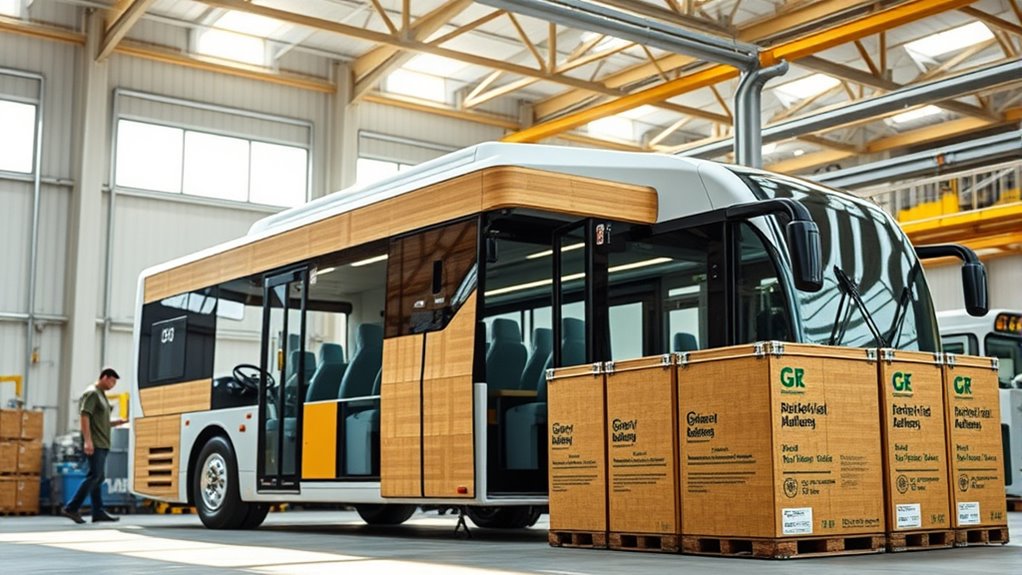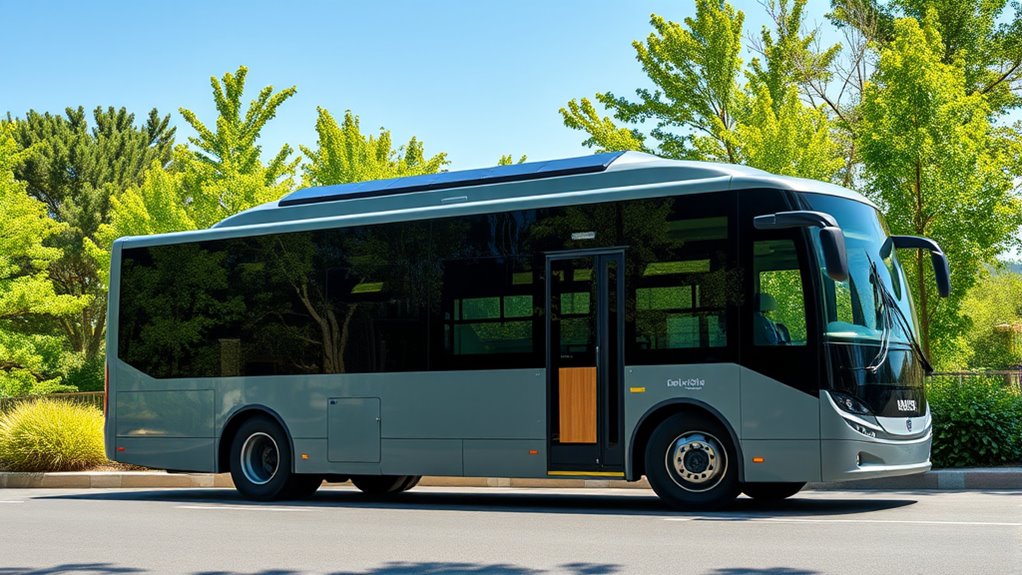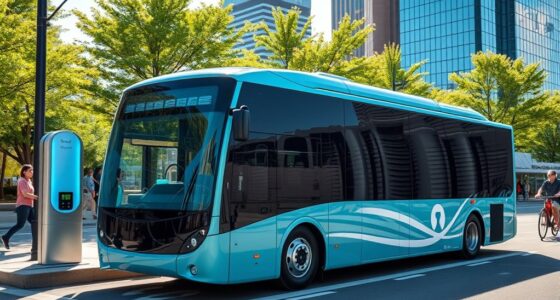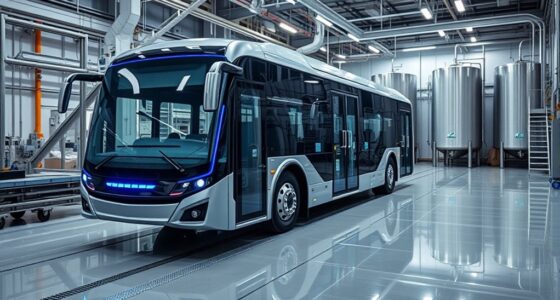In electric bus manufacturing, sustainable materials like recycled metals, eco-friendly plastics, and natural fibers are gaining popularity. These materials help reduce overall emissions, weight, and waste while improving durability and efficiency. Innovations like bioplastics and composites made from renewable sources are further advancing eco-friendly design. By choosing these sustainable options, manufacturers can meet stricter regulations and satisfy eco-conscious consumers. To discover more about these groundbreaking materials, there’s plenty more to explore.
Key Takeaways
- Recycled metals like aluminum and steel reduce resource consumption and weight, enhancing bus efficiency.
- Bioplastics and natural fibers provide biodegradable, lightweight alternatives that support sustainability and performance.
- Eco-friendly coatings with low VOCs minimize emissions during manufacturing and operation.
- Circular economy practices, such as battery recycling and component reuse, extend vehicle lifespan and reduce waste.
- Industry trends favor sustainable materials driven by regulations, market demand, and ongoing innovations in eco-friendly composites.

Are sustainable materials shaping the future of electric bus manufacturing? Absolutely. As someone involved in this industry, you’re likely aware that integrating eco-friendly materials isn’t just a trend—it’s a necessity for reducing environmental impact and meeting regulatory standards.
Recycled metals, such as aluminum and steel, play a crucial role here. Using these materials conserves natural resources and cuts energy consumption during production, making buses lighter and more efficient.
Recycled metals reduce resource use and energy, making electric buses lighter and more efficient.
Bioplastics, derived from renewable sources, offer biodegradable alternatives to conventional plastics. They help lower carbon footprints and reduce plastic waste, especially in interior components and exterior trims.
Natural fibers like hemp and flax are increasingly used as reinforcements in composites, contributing to weight reduction without sacrificing strength. This not only improves fuel efficiency but also supports sustainable agriculture practices.
Eco-friendly coatings are another key element. They employ paints with low VOCs, which release fewer harmful emissions and are safer for both workers and the environment. These coatings help maintain vehicle durability while minimizing health risks associated with traditional paints.
The circular economy is central to sustainable materials use. Encouraging reuse and recycling of parts and materials extends the lifecycle of components and reduces waste. For example, battery recycling and second-life applications allow used batteries to be repurposed for energy storage or other uses, decreasing mineral extraction and waste generation.
Chassis repurposing and material recycling programs help close the loop, ensuring materials are reused rather than discarded, further supporting sustainability goals.
Adopting sustainable materials offers significant environmental benefits by drastically reducing the emissions and waste associated with manufacturing. Performance and durability often improve, leading to more reliable vehicles that require fewer replacements.
While the initial costs of these eco-friendly materials can be higher, long-term savings from energy efficiency and waste reduction often offset these expenses.
Governments and regulatory bodies increasingly support these efforts through incentives and stricter environmental standards, pushing the industry toward greener practices.
In terms of innovation, advances in bioplastics and sustainable composites continue to emerge. Researchers are developing new bioplastics with even lower carbon footprints, and natural fiber-reinforced composites promise lightweight, durable, and sustainable alternatives.
Additionally, sustainable material adoption is gaining momentum as a core strategy for manufacturers aiming to meet future environmental standards and consumer expectations.
These innovations will further transform how electric buses are built, making them more eco-friendly and efficient.
By embracing sustainable materials, you’re not only contributing to a healthier planet but also positioning your manufacturing process for future growth and compliance.
This shift toward sustainable materials is shaping the electric bus industry into a cleaner, more responsible, and innovative sector.
Frequently Asked Questions
How Do Sustainable Materials Affect Electric Bus Cost and Affordability?
You might notice that sustainable materials can raise the upfront cost of electric buses because they’re often more specialized. However, you save money over time through lower fuel and maintenance expenses, plus government incentives can help offset initial costs.
As demand grows and production scales up, prices tend to decrease. By choosing eco-friendly options, you contribute to long-term savings and a greener future while making transportation more affordable.
Are Sustainable Materials as Durable as Traditional Alternatives in Bus Manufacturing?
You wonder if sustainable materials match traditional ones in durability. While they often seem less proven, advances like carbon fiber composites and eco-friendly plastics now offer comparable strength and longevity.
Instead of sacrificing performance, you’re gaining lighter, recyclable components that reduce environmental impact. With proper selection and testing, sustainable materials can stand up to traditional alternatives, ensuring your electric bus remains durable, efficient, and eco-conscious throughout its lifespan.
What Are the Environmental Impacts of Sourcing Sustainable Materials?
You might wonder about the environmental impacts of sourcing sustainable materials. When you choose these materials, you reduce carbon emissions, conserve water, and lower energy consumption during production.
You also help preserve natural resources and minimize waste. By sourcing sustainably, you’re supporting cleaner environments, reducing environmental risks, and aligning with global standards.
This approach benefits both the planet and your company’s reputation, showing your commitment to responsible manufacturing practices.
How Do Sustainable Materials Influence Electric Bus Recycling Processes?
Like a well-tuned machine, sustainable materials streamline electric bus recycling. You’ll find that modular battery designs and high-grade recovery methods make disassembly easier, boosting reuse and recycling efficiency.
Recycled metals and traceable raw materials guarantee a cleaner supply chain. Plus, second-life applications extend battery lifespan, reducing waste.
All these factors work together, simplifying processes and making recycling more environmentally friendly, just like a smoothly running system.
Are There Any Certifications for Sustainable Materials Used in Electric Buses?
You’re wondering if there are certifications for sustainable materials used in electric buses. While specific certifications for individual materials are limited, several programs promote overall sustainability and responsible sourcing.
For example, ecolabels verify environmentally friendly manufacturing, and certifications like TRUE focus on waste reduction and resource efficiency. Additionally, standards like ISO 14001 and circular economy metrics guide sustainable material use, helping you identify environmentally responsible components in electric buses.
Conclusion
By choosing sustainable materials for electric bus manufacturing, you’re helping to steer the industry toward a greener future. These eco-friendly options not only reduce environmental impact but also prove that doing the right thing pays off in the long run. Remember, every small step counts, and by supporting sustainable practices, you’re truly on the right track. So, don’t let this opportunity slip through your fingers—embrace innovation and make a lasting difference today.









